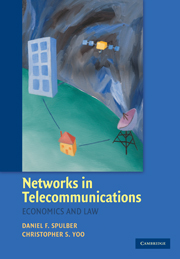Book contents
- Frontmatter
- Contents
- Preface
- Acknowledgments
- Introduction
- PART I THE ECONOMICS OF NETWORKS
- PART II THE REGULATION OF NETWORKS
- PART III POLICY APPLICATIONS
- 8 The Regulation of Local Telephone Networks
- 9 Antitrust as Applied to Network Industries
- 10 The Regulation of Last-Mile Broadband Networks
- 11 The Regulation of Broadband Networks and the Internet: Network Neutrality versus Network Diversity
- 12 The Regulation of Broadband Networks and the Internet: Network Neutrality versus Network Capacity
- Conclusion
- Bibliography
- Index
- Table of Cases
12 - The Regulation of Broadband Networks and the Internet: Network Neutrality versus Network Capacity
Published online by Cambridge University Press: 05 June 2012
- Frontmatter
- Contents
- Preface
- Acknowledgments
- Introduction
- PART I THE ECONOMICS OF NETWORKS
- PART II THE REGULATION OF NETWORKS
- PART III POLICY APPLICATIONS
- 8 The Regulation of Local Telephone Networks
- 9 Antitrust as Applied to Network Industries
- 10 The Regulation of Last-Mile Broadband Networks
- 11 The Regulation of Broadband Networks and the Internet: Network Neutrality versus Network Diversity
- 12 The Regulation of Broadband Networks and the Internet: Network Neutrality versus Network Capacity
- Conclusion
- Bibliography
- Index
- Table of Cases
Summary
During the Internet's initial, narrowband phase of development, Internet service providers (ISPs) pursued a variety of architectural approaches. Some ISPs, such as CompuServe, Prodigy, and America Online, initially adopted relatively restrictive policies, which only provided end users with access to proprietary applications and content and charged them for network usage on a per-minute basis. Others followed a more permissive approach, opening up their networks to all content and applications providers on a nondiscriminatory basis and allowing end users to download any content, run any application, and attach any device for a flat monthly fee. The latter approach ultimately proved more attractive to consumers, and end users became accustomed to a world in which they faced few restrictions either on the ways they could use their network connections or on the amount of bandwidth they consumed.
This same debate has resurfaced as the Internet has begun to migrate from a narrowband to a broadband architecture. Once again, network owners have begun to experiment with more restrictive approaches. With respect to end users, some network owners have begun to offer bandwidth tiers to end users, in which the amount that customers pay varies with the amount of bandwidth with which they are provided. Others have placed restrictions on end users' latitude to run certain applications or attach certain devices. Still others have considered alternative pricing relationships with respect to content and applications providers, under which transmission speed would depend on the tier of service purchased.
- Type
- Chapter
- Information
- Networks in TelecommunicationsEconomics and Law, pp. 405 - 432Publisher: Cambridge University PressPrint publication year: 2009



